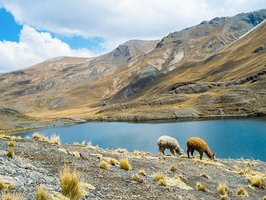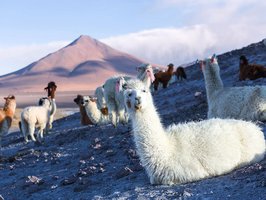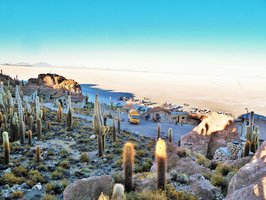Bolivia Travel Information
You are planning a trip to Bolivia? There is a lot to know before you board the airplane. On this site you can find all the important information you need. Get to know more about the entry and exit requirements, the country, climate and the locals. SC Travel Adventures is taking you to an unique and adventurous country.
Entry & Exit
For your trip to Bolivia you don't need a visa for stays up to 30 days. You can extend this amount for another 30 days twice. It's important to apply at the General Directorate of Migration before the end of your first 30 days. During one calendar year you can stay in Bolivia up to 90 days without a visa.
If you are arriving to Bolivia via bus or car you need to get a arrival stamp in your passport. Sometimes nightbuses are not stoping at the borders. This can lead to problems and penalty fees at your departure.
For the custom regulations at your reentry to Canada/UK please see special regulations at Global Affairs Canada or the Foreign and Commonwealth Office.
Sometimes you need to provide evidence of a vaccination certificate for Yellow Fever for all persons older than one year.
Before travelling to Bolivia we recommend to get a consultancy with a doctor specialized in the tropics and travel medicine.
Zika virus
In the past years the was a raise in the spreading of the Zika virus. Pregnant women are disadvised to travel to Bolivia
Yellow Fever
Endangered regions for Yellow Fever in Bolivia are all areas below 2.300 m of altitude. This includes the whole Amazon region of Bolivia. You should get a vaccination at least 10 days before arrival to Bolivia.
Dengue Fever
Fever, growing pains and rashes are typical symptoms for Dengue fever.
At the moment there is no vaccination or any other method of protection against Dengue fever. You should avoid to be bitten by mosquitos by using repellents and try to wear long sleeves.
Chikungunya
The Chikungunya virus is transmitted by the same mosquito like the Dengue fever. You should use the same protection measures.
Malaria
There is a high risk for Malaria in the provinces Beni, Pando and Tarija. In the rest of the lowlands under 2500m of altitude there is still a medium risk. For people travelling to the jungle a chemoprophylaxis can be an advantage. This treatment can't prevent a outbreak of the illness a 100%.
Altitude Sickness
In heights above 2500 m there's a risk of altitude sickness if you are raising to fast. Symptoms can be insomnia, headache and vomiting. If you are not feeling better after one day, we recommend to descend under 2000 m.
A foreign health insurance for the duration of the trip is recommendable. This insurance should include a return transport.
The health care infrastructure in bigger cities is comparable with Europe or Canada. In rural areas you can find technical and hygienic differences.
Travel Facts for Bolivia
Generally you can visit Bolivia all year. The best time to travel, however, are the winter months from May to October because of less rainfall. In the rainy season from November to April you can have problems with transportation due to floodings.
Despite the fact that Bolivia is located at the equator, the climate is not sub tropical in all regions. In Altiplano you can find a moderate climate, while the lowlands are predominantely humid and tropical.
Bolivia falls into the UTC/GMT -4 time zone and doesn't make use of daylight savings time.
The official currency of Bolivia is the Boliviano (1 Boliviano = 100 Centavos). Banknotes are available in 10, 20, 50, 100 and 200 Bolivianos. Coins are available in 10, 20, 50 Centavos and 1, 2, 5 Bolivianos.
1 CAD = 5,19 Bolivianos (last updated 04.09.2019)1 £ = 8,43 Bolivianos (last updated 04.09.2019)
In the bigger cities withdrawing money at ATM's is possible with all popular credit cards. It can be more problematic in rural areas. We recommend to always have enough cash with you.
Electricity
The line voltage in Bolivia is usually at 110 volt or 220 volt / 50 hertz. In isolated regions it's possible to have periods of tie without any electricity (for example Amazon region). In these cases we recommend to bring a flashlight. To use the plug sockets you need an US-American adapter.
Telephone
International dialing code: +591
You can use the telephone in Bolivia in almost all places of the country. In the cities you can use one of the many telephone shops and even in rural and isolated villiges of the Andes little telephone huts are common.
Internet
Internet café are popular in the cities and villiges with a lot of tourists. The connection can be quit slow.
2678, Calle Victor Sanjinez, Edificio Barcelona, 2nd Floor, Plaza España (Sopocachi), La Paz, Bolivia
Tel.: +591 2 241 5141 Embassy of Canada
Calle Bolognesi 228, Miraflores, Lima 15074, Peru
Tel.: +51 1 319 3200
Internet: www.peru.gc.caBritish Embassy
Avenida Acre No. 2732, La Paz, Bolivia
Tel.: +591 2 243 3424
Internet: www.gov.uk/contact-consulate-la-pazEmergency numbers
Ambulance: 118
Tourist police: 02 222 5016
People & Landscape
Bolivia is the poorest country of South America. The capital is Sucre but the government is located in La Paz. Evo Morales Ayma is the first indigenous person ruling the country since 2006. 10,3 million people are living in Bolivia, 60% are indigenous.
The official language of Bolivia is Spanish but every region has another indiginous language as a official language as well. The most popular are Quechua, Aimara and Guaraní. 80% of the population is speaking Spanish but in rural areas it's possible, that you only find people speaking indigenous languages.
the culture of Bolivia is highly influenced by the indigenous cultures of the Andes. Music an dance plays an important role in Bolivia like in all other countries of South America. The music of the Andes is full of melancholic sounds and is from the times of the Inkas. There are also many dances like the cueca or the auqui-augui, that are part of the daily life.
About 90% of the population are catholic but also natural religions are very important in the country. The most popular among them is the worship of Pachamama - the mother earth for the rich harvest and a healthy family.
Bolivia is full of suprises and has many facettes. In the west the Andes are extending, the east you can find the subtropical Yungas and moderate and tropical lowlands.
Landscape highlights of the Altiplanos (highlands) are the Salar de Uyuni, the biggest salt desert, and the Titicacalake, the highest navigable lake in the world. On the lake you can find the Isla del Sol (sun island) and the Isla de la Luna (moon island), which are the places of origin in the history of creation of the Inkas.
Due to less population in Bolivia you can find a higher animal diversity than in other countries of South America. Meet, for example, Andean Bears, jaguars, anteaters, tapirs, capybaras, aligators and condors.



Part of the main foods in Bolivia are potatoes, corn, Quinoa and sorghum. In the region of the Titicacalake you can also find a lot of trucha (trout). In the restaurants you can spice your dishes individually with Ilajhua - a spicy sauce made of tomatos and chilis.
A popular beverage, which is also good if you are suffering from altitude sickness, is the Mate de Coca - a tea, which is made from pouring water on Coca-leaves. The leaves can also be eaten to enhance the performance. The consumption and possession of the leaves is legal in Bolivia but in other countries it is illegal. Traditional alcoholic beverages are Chicha, a beer made from beer, and and Singani, brandy and the national drink of Bolivia.
If you are well informed about Boliva now, have a look at our Trips to Boliva or contact our team.
Current Situation
Please keep in mind, that the security situation at place can change at any time. Therefore we recommend to have a look at the current safety information at Global Affairs Canada or Foreign and Commonwealth Office.
Exclusion of Liability
Those who choose to travel do so entirely at their own risk. SC Travel Adventures endeavours to inform tourists of the risks involved with travelling but cannot be held liable for any events which occur outside of their direct control. Tourists are advised to avoid areas considered unsafe, remain vigilant and cautious at all times throughout their stay, and heed the advice of local authorities.
